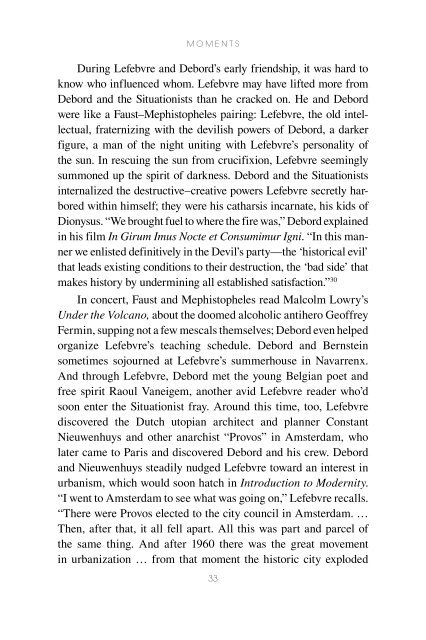Henri Lefebvre: A Critical Introduction - autonomous learning
Henri Lefebvre: A Critical Introduction - autonomous learning
Henri Lefebvre: A Critical Introduction - autonomous learning
Create successful ePaper yourself
Turn your PDF publications into a flip-book with our unique Google optimized e-Paper software.
M o M e n t s<br />
During <strong>Lefebvre</strong> and Debord’s early friendship, it was hard to<br />
know who influenced whom. <strong>Lefebvre</strong> may have lifted more from<br />
Debord and the Situationists than he cracked on. He and Debord<br />
were like a Faust–Mephistopheles pairing: <strong>Lefebvre</strong>, the old intellectual,<br />
fraternizing with the devilish powers of Debord, a darker<br />
figure, a man of the night uniting with <strong>Lefebvre</strong>’s personality of<br />
the sun. In rescuing the sun from crucifixion, <strong>Lefebvre</strong> seemingly<br />
summoned up the spirit of darkness. Debord and the Situationists<br />
internalized the destructive–creative powers <strong>Lefebvre</strong> secretly harbored<br />
within himself; they were his catharsis incarnate, his kids of<br />
Dionysus. “We brought fuel to where the fire was,” Debord explained<br />
in his film In Girum Imus Nocte et Consumimur Igni. “In this manner<br />
we enlisted definitively in the Devil’s party—the ‘historical evil’<br />
that leads existing conditions to their destruction, the ‘bad side’ that<br />
makes history by undermining all established satisfaction.” 30<br />
In concert, Faust and Mephistopheles read Malcolm Lowry’s<br />
Under the Volcano, about the doomed alcoholic antihero Geoffrey<br />
Fermin, supping not a few mescals themselves; Debord even helped<br />
organize <strong>Lefebvre</strong>’s teaching schedule. Debord and Bernstein<br />
sometimes sojourned at <strong>Lefebvre</strong>’s summerhouse in Navarrenx.<br />
And through <strong>Lefebvre</strong>, Debord met the young Belgian poet and<br />
free spirit Raoul Vaneigem, another avid <strong>Lefebvre</strong> reader who’d<br />
soon enter the Situationist fray. Around this time, too, <strong>Lefebvre</strong><br />
discovered the Dutch utopian architect and planner Constant<br />
Nieuwenhuys and other anarchist “Provos” in Amsterdam, who<br />
later came to Paris and discovered Debord and his crew. Debord<br />
and Nieuwenhuys steadily nudged <strong>Lefebvre</strong> toward an interest in<br />
urbanism, which would soon hatch in <strong>Introduction</strong> to Modernity.<br />
“I went to Amsterdam to see what was going on,” <strong>Lefebvre</strong> recalls.<br />
“There were Provos elected to the city council in Amsterdam. …<br />
Then, after that, it all fell apart. All this was part and parcel of<br />
the same thing. And after 1960 there was the great movement<br />
in urbanization … from that moment the historic city exploded<br />
33
















